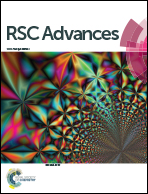Effects of cerebral glucose levels in infarct areas on stroke injury mediated by blood glucose changes†
Abstract
Admission hyperglycemia is considered to be related to poor outcomes of ischemic stroke. However, there is controversy regarding effects of attempts to lower blood glucose in stroke patients. This study aimed at determining the effects of blood glucose fluctuation on stroke injury by detection of cerebral glucose levels. A single intraperitoneal injection of glucose (0, 0.5, 1, 1.5 or 2 g kg−1) at 5 min before reperfusion caused blood glucose fluctuation (5–15 mmol L−1) lasting for 2 h after reperfusion. Blood glucose levels of 6–10 mmol L−1 decreased stroke injury after reperfusion for 24 h and 28 days compared with conditions of hyperglycemia (>10 mmol L−1) and hypoglycemia (<6 mmol L−1). High glucose concentration increased neuronal injury and death after oxygen–glucose deprivation. Under hyperglycemia and hypoglycemia, elevations in expression of MMP-2/-9 and decrease of tight junction proteins including occludin, claudin-5 and ZO-1 contributed to blood–brain barrier (BBB) dysfunction in infarct regions after ischemia–reperfusion injury, and reduction of hexokinase, pyruvate kinase and lactate dehydrogenase activities significantly inhibited the glucose metabolism in cortex and striatum after 24 h of reperfusion. BBB damage and reduced glucose metabolism caused accumulation of glucose in infarct areas. An obvious increase in cerebral glucose levels aggravated stroke injury.


 Please wait while we load your content...
Please wait while we load your content...